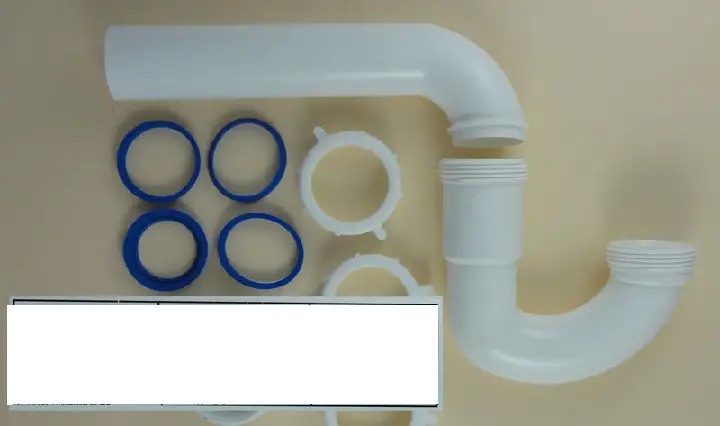Water flowing from the sink to the plumbing trap- speeds up as it reaches the bottom. It then flows over the “hill” and into the drain, and that’s why this discussion centers on whether you can install reverse p-traps as part of your plumbing system.
You can incorporate a reverse p-trap into your drain, but you should couple it with a few unique modifications. It may look okay at first sight, even after mounting it backward.
Failure to tweak some settings on the plumbing would clog your p-trap with debris, inhibiting water from draining correctly.
Manufacturers designed p-traps to self-clean because of their configuration. Find out more from the article.
Can A P Trap Go Either Way?
If the p-trap features are too low in the drain line, you may not get the appropriate slope.
The option left is the reverse the p trap. Although a p trap can go either way it is highly not advisable because it will not serve its purpose well of retaining sewer gases from going up to the room.
Professionals advise you to lower the drain into the wall-although this process is time-consuming. It can worsen the situation if you have garbage disposal below the sink.
You can adopt either of these unconventional solutions if you can assemble everything but cannot form a trap in the waste disposal.
The Unconventional Solution
As stated earlier, reverse p-traps would serve you well, provided you add special fittings to them; otherwise, employ the following:
- A threaded link and a 1 1/2 inches ID aligning to 1 1/2 inches OD with a threaded attachment intended to accommodate a tapered ring; add the gizmo after the reverse P trap. It will fill the 2-inch gap.
- Another option is to use a metal p trap, but you’ll have about 1/2′′ of grip on the short end.
- Make your p-trap from PVC pipe or ABS and not use the conventional p-trap set.
See also How Far Below Drain Can p trap be?
Can You Turn a P Trap Backwards?
It is not advisable for you to turn a p trap backwards because professionals recommend that when installing p-traps, ensure the outlet of the pipe is lower than its inlet.
Placing the trap in a reverse manner could create an over 4-inch trap seal, which heightens the risk of clogging-and that’s a detailed explanation for why several homeowners don’t fancy reverse p-traps.
Before stating why many homeowners don’t install reverse p-traps in their apartments, let’s define some terms for an easy breakdown.
A “trap” is a U-shaped pipe design under a sink that captures and retains water after the sink drains. It produces a liquid block that prevents any unpleasant sewage gas from escaping the drain and into your house.
A “trap arm” is the plumbing from the trap that stretches into the wall. The entire assembly is known as a “P-trap” because of its sideways P-shape.
Moreover, the trap seal refers to the level of the water column that keeps sewage gas at bay. The trap’s weir is at the top, while the trap dip comes at the bottom.
The least trap seal is 2 inches, while building requirements set a maximum of 4 inches. A trap less than 2 inches in diameter will not provide safeguards against any gas pressure breaching the seal.
A reverse p-trap with a diameter of more than 4 inches, on the other hand, will cause the trap to clog.
Professionals recommend that when installing p-traps, ensure the outlet of the pipe is lower than its inlet. Placing the trap in a reverse manner could create an over 4-inch trap seal, which heightens the risk of clogging-and that’s a detailed explanation for why several homeowners don’t fancy reverse p-traps.
Furthermore, no reputable plumber would make such an error, implying that a maintenance worker probably did the task. However, a reverse p-trap would do more than no trap at all.
See also How Deep Can a P Trap Be?
What is the difference between J Bend and P Trap
A J bend and a p trap mean one and the same thing. The piping under the sink can take the shape of a J, a U or a P trap but they all serve the same purpose of preventing sewer gases from entering the room.
They do this by retaining a small amount of water in the bend creating a seal that blocks the gases.
Which Way Do You Turn a P Trap
When assembling and mounting the p-trap, cement the 90-degree piece onto the side that’s not bent. After that, attach the curved side to the shower outlet.
However, ensure the gluing of the p-trap doesn’t affect the drainage.
Concluding Thoughts
As shown in the article, you can install reverse p-traps as part of your plumbing network to help drain wastewater. However, a few changes are required for the plumbing traps to meet drainage needs adequately.
A well-fitted p-trap feature has an outlet that’s lower than its inlet. Reverse traps form a trap seal of over four inches, making the drain susceptible to clogging- and that explains why many shy away from them.
You can reverse the trap. However, when you do that, the tail bit that goes into the trap is merely 5/8 inches, making it an unreliable connection.
See also Can P Trap be Higher than drain pipe

